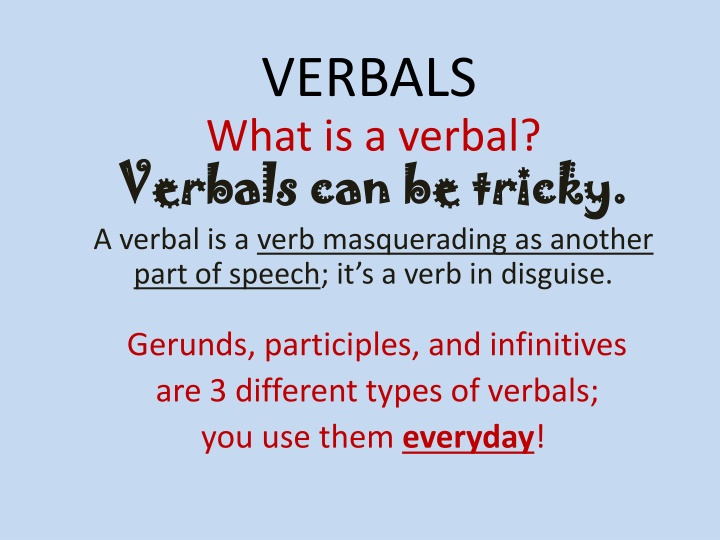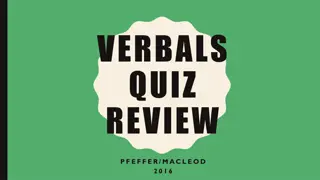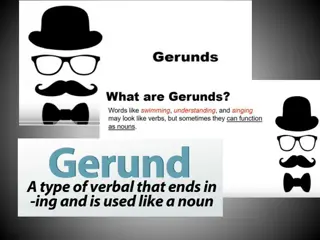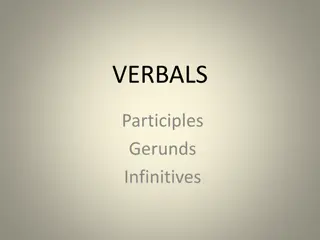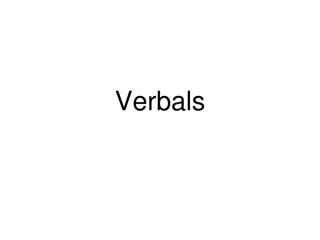VERBALS
Discover the intricacies of verbals, including gerunds, participles, and infinitives. Learn about the functions of each verbal type, differentiate the forms of verbs, and practice identifying and using verbals in sentences.
Download Presentation

Please find below an Image/Link to download the presentation.
The content on the website is provided AS IS for your information and personal use only. It may not be sold, licensed, or shared on other websites without obtaining consent from the author.If you encounter any issues during the download, it is possible that the publisher has removed the file from their server.
You are allowed to download the files provided on this website for personal or commercial use, subject to the condition that they are used lawfully. All files are the property of their respective owners.
The content on the website is provided AS IS for your information and personal use only. It may not be sold, licensed, or shared on other websites without obtaining consent from the author.
E N D
Presentation Transcript
VERBALS What is a verbal? Verbals can be tricky. A verbal is a verb masquerading as another part of speech; it s a verb in disguise. Verbals can be tricky. Gerunds, participles, and infinitives are 3 different types of verbals; you use them everyday!
-- --Gerunds Gerunds-- -- A gerund is the form of a verb that ends in ing and functions as a NOUN in a sentence. In a sentence, a gerund can have 3 different functions: EX 1: Shopping is excellent recreation. The noun shopping is the subject of this sentence. EX 2: My friends and I like shopping. The noun shopping is the direct object of the verb. EX 3: Mom gave me money for shopping. The noun shopping is the object of the preposition for.
Participle Participle Definition: A participle the verb form ending in d, ed, or ing that is used as an ADJECTIVE. (past participle adds d or ed to the verb stem) (present participle adds ing to the verb stem) The butterfly fluttering near the daisy is a monarch. (The adjective fluttering modifies butterfly. )
What does FORM OF A VERB mean? The different parts of a verb, for ex: Verb base or stem ----jump Present participle = add ing ----jumping Past Past participle = add --ed ----jump ----jumped (if a verb ends in e, add only d; ex: skated) ELA Red Text Chapter 18 Using Verbs Correctly pg 506+ See also: http://www.grammar- monster.com/lessons/verbs.htm
1. What is the difference in the function of the word FISHING FISHING in each sentence below? __________Is fishing fun? (Turn the question into a statement to help you determine the parts of the sentence: Fishing is fun.) __________Go get the fishing equipment. __________I suggest he get a fishing license before he decides to go fishing. 2. Determine web mood for each sentence 3. Write 3 sentences using an ing or d/ed word as an ADJECTIVE
INFINITIVE INFINITIVE = to + verb An infinitive is a verb form introduced by the word to that can be used as a noun, an adjective, or an adverb. I plan to read a book on Saturday. (The infinitive to read is a noun used as a direct object, so it is a noun.) Memory Trick: An infinitive is as easy to see as a black-eyed pea.
Determine the infinitive. __________We would like to fish on Saturday if the boat is repaired. __________Is it time to go to lunch? __________ When we go to a Mexican restaurant, I always want to get cheese dip. __________ When we get to work quickly, we learn more!
Infinitive practice On your own, try writing 3 sentences that include infinitives. An infinitive consists of to + a verb base. Example: I would like to see a movie this Friday.
